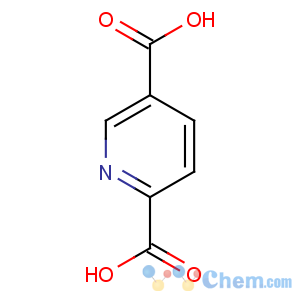Title: Isocinchomeronic Acid
CAS Registry Number: 100-26-5
CAS Name: 2,5-Pyridinedicarboxylic acid
Molecular Formula: C7H5NO4
Molecular Weight: 167.12
Percent Composition: C 50.31%, H 3.02%, N 8.38%, O 38.29%
Literature References: Prepd by treating 5-ethyl-2-picoline (aldehyde-collidine) with suitable oxidizing agents such as HNO3, KMnO4, or H2SeO3: Meyer, Staffen,
Monatsh. Chem. 34, 517 (1913); Jordan,
Ind. Eng. Chem. 44, 332 (1952); Kato,
Bull. Chem. Soc. Jpn. 34, 636 (1961); by oxidation of 5-acetyl-2-methylpyridine: Binns, Swan,
J. Chem. Soc. 1962, 2831; from the lutidine fraction of coal tar lutidine: Lukes
et al., Collect. Czech. Chem. Commun. 26, 3044 (1961).
Properties: Triclinic leaflets or prisms from dilute HCl, mp 254°. Sublimes as nicotinic acid when heated above mp. Practically insol in cold water, alcohol, ether, benzene. Slightly sol in boiling water, boiling alcohol. Appreciably sol in hot, dil aq solns of mineral acids.
Melting point: mp 254°
Derivative Type: Monohydrate
Properties: Crystals from water or alcohol, dec 238°.
Derivative Type: Dihydrazide
Properties: Crystals, mp 268-269°.
Melting point: mp 268-269°
Use: Intermediate in the manuf of nicotinic acid.

